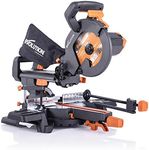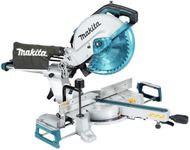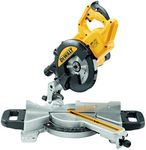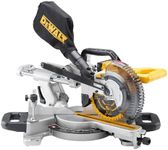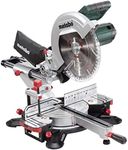Buying Guide for the Best Sliding Miter Saws
Choosing the right sliding miter saw can make a significant difference in the quality and efficiency of your woodworking projects. A sliding miter saw is a versatile tool that allows you to make precise crosscuts and miters in a variety of materials. To find the best fit for your needs, it's important to understand the key specifications and how they impact the saw's performance. Here are the main specs to consider when selecting a sliding miter saw.Blade SizeThe blade size of a sliding miter saw determines the maximum depth and width of the cut it can make. Common blade sizes are 7-1/4 inches, 10 inches, and 12 inches. Smaller blades (7-1/4 inches) are suitable for lighter, more precise work, while larger blades (12 inches) can handle bigger, thicker materials. Choose a blade size based on the type of projects you plan to undertake. For general home improvement tasks, a 10-inch blade is often sufficient.
Motor PowerMotor power, measured in amps, affects the saw's ability to cut through different materials. Higher amp motors (15 amps) provide more power and can handle tougher materials like hardwoods and thick lumber. Lower amp motors (10-12 amps) are suitable for lighter, less demanding tasks. Consider the types of materials you will be cutting most frequently to determine the appropriate motor power for your needs.
Cutting CapacityCutting capacity refers to the maximum width and thickness of the material the saw can cut. This is influenced by the blade size and the sliding mechanism. A larger cutting capacity allows for more versatility in the types of cuts you can make. If you plan to work with larger pieces of wood or need to make wide crosscuts, look for a saw with a higher cutting capacity. For smaller, more detailed work, a lower cutting capacity may be sufficient.
Bevel RangeThe bevel range indicates the angles at which the saw can tilt to make bevel cuts. A single bevel saw tilts in one direction, while a dual bevel saw tilts in both directions. Dual bevel saws offer more flexibility and can save time by allowing you to make complex cuts without repositioning the material. If you frequently make bevel cuts, especially in crown molding or other detailed work, a dual bevel saw is a better choice.
Sliding MechanismThe sliding mechanism allows the saw to move forward and backward, increasing the cutting capacity. This feature is particularly useful for cutting wider boards. If you often work with large, wide pieces of wood, a sliding miter saw is essential. For smaller projects or if space is limited, a non-sliding miter saw may be adequate.
Laser GuideA laser guide projects a line onto the material, indicating where the blade will cut. This feature enhances accuracy and helps ensure precise cuts. If precision is crucial for your projects, such as in fine woodworking or detailed trim work, a saw with a laser guide can be very beneficial. However, for rough cuts or less detailed work, this feature may not be as necessary.
Dust CollectionDust collection systems help keep your workspace clean by capturing sawdust and debris. Effective dust collection is important for maintaining a clear line of sight and reducing cleanup time. If you work in a small or enclosed space, or if you prioritize cleanliness, look for a saw with a good dust collection system. For outdoor or less frequent use, this feature may be less critical.

